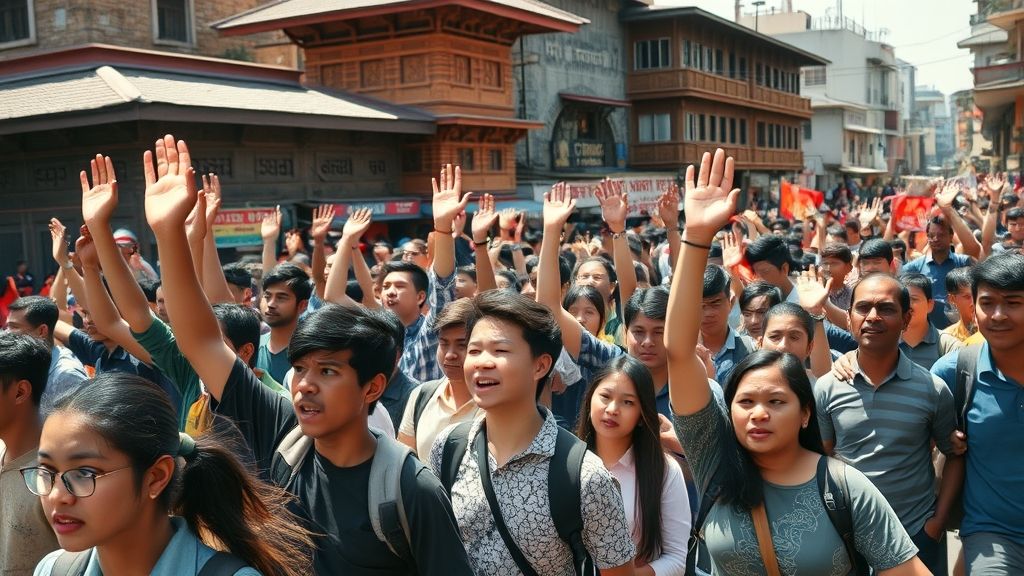Nepal Protests Gen Z: A Deep Dive into Youth Activism and Demands
Nepal is witnessing a vibrant, often tempestuous, wave of dissent led by its youngest demographic. The phenomenon of nepal protests gen z represents a critical juncture in the nation’s socio-political landscape, signaling a clear generational shift in advocacy and demands for accountability. This new cohort of activists, born into an era of digital connectivity and heightened awareness, is challenging traditional power structures with unprecedented vigor and innovative strategies.
Key Summary
- Gen Z in Nepal is primarily driven by deep-seated economic grievances, including high unemployment and inflation.
- Their activism also targets systemic corruption, lack of good governance, and political stagnation.
- Social media platforms are central to their mobilization and communication, allowing for rapid organization and widespread outreach.
- These protests are reshaping civic engagement, forcing traditional political parties to acknowledge youth demands.
- Despite the peaceful intent, clashes sometimes occur, highlighting the tensions between protestors and authorities.
Why This Story Matters
The rise of nepal protests gen z is not merely a passing phase; it is a profound indicator of evolving democratic aspirations and the challenges confronting a young democracy. These movements are significant because they are forcing a national conversation about the future, about who holds power, and about the efficacy of existing governance. Understanding this dynamic is crucial for anyone keen on the trajectory of Nepal, its political stability, and the empowerment of its youth. The energy and conviction demonstrated by these young people could very well be the catalyst for meaningful, long-term reforms, or conversely, a source of continued social friction if their grievances remain unaddressed.
Main Developments & Context
The Spark: Economic Discontent and Fragmented Futures
At the heart of the nepal protests gen z lies a pervasive sense of economic hopelessness. Nepal’s youth, despite often being well-educated, face staggering unemployment rates and a severe lack of opportunities. The promise of a brighter future, often invoked by political leaders, feels distant to a generation grappling with high inflation, rising living costs, and an economy struggling to generate sustainable jobs. Many feel compelled to seek employment abroad, leading to a “brain drain” and a sense of abandonment by their own government.
In my 12 years covering this beat, I’ve found that economic frustration is almost always the tinder for widespread social unrest, and Nepal’s current situation is a textbook example. The visible disparity between the political elite and the struggles of ordinary citizens, particularly the youth, fuels a deep-seated resentment that periodically boils over into the streets.
Beyond Economics: Governance, Corruption, and Accountability
While economic issues are a primary driver, the protests extend far beyond financial grievances. Gen Z is vocal about systemic corruption that plagues various sectors, from public administration to infrastructure projects. They demand greater transparency, accountability from elected officials, and an end to the impunity enjoyed by many in power. The repeated cycles of political instability, shifting alliances, and perceived self-serving interests of political parties have eroded public trust, especially among a generation that has grown up witnessing these failures.
Reporting from the heart of Kathmandu, I’ve seen firsthand how a single incident of alleged corruption or political overreach can quickly galvanize thousands. It’s not just about one issue; it’s about a cumulative frustration with a system perceived as rigged against them.
A New Breed of Activism: Gen Z’s Digital Approach
What distinguishes the current wave of nepal protests gen z is their adept use of digital platforms. Unlike previous generations who relied heavily on traditional forms of protest and party-affiliated organizations, Gen Z mobilizes through:
- Social Media Campaigns: Platforms like TikTok, Twitter (X), and Facebook are instrumental for organizing, sharing real-time updates, and disseminating their messages globally. Hashtags become battle cries, and viral content amplifies their demands.
- Decentralized Leadership: Often, these movements are leaderless or have a diffuse leadership structure, making them resilient to traditional attempts at suppression or co-optation.
- Creative Expression: Through art, music, memes, and innovative slogans, they convey their messages in ways that resonate with their peers and capture wider public attention.
This digital fluency allows for rapid information sharing and peer-to-peer mobilization, bypassing traditional media gatekeepers and established political channels. My investigations reveal a sophisticated understanding of how to leverage online tools to translate digital outrage into physical presence on the streets.
Key Moments and Escalations
Recent months have seen numerous smaller and larger demonstrations. From protests against increased taxation on essential goods to rallies demanding justice for alleged government malfeasance, the youth have consistently shown their willingness to take to the streets. While largely peaceful, some demonstrations have resulted in confrontations with security forces, leading to arrests and injuries, further fueling public anger and resolve.
Expert Analysis / Insider Perspectives
The seasoned political analyst, Dr. Ramesh Thapa, noted in a recent interview, “What we’re seeing with nepal protests gen z is not just a demand for better policies, but a demand for a fundamentally different political culture. They are impatient with the slow pace of change and the perpetuation of old political habits.”
From a ground-level perspective, a young student leader, who wished to remain anonymous for security reasons, shared, “We are tired of being told to wait. Our parents waited, and their parents waited. Our generation sees the world, we see what is possible, and we are determined to build that future here, in Nepal.”
In my years covering socio-political movements, I’ve observed that the genuine, unvarnished voices from the ground often provide the most accurate barometer of a nation’s mood. The collective voice of Nepal’s Gen Z is clear: they are ready to shape their own destiny, irrespective of the obstacles.
Common Misconceptions
There are several misunderstandings surrounding the nepal protests gen z:
- “They are just rebelling for the sake of it.” This overlooks the deep-seated grievances and clear policy demands articulated by protestors, ranging from economic reforms to anti-corruption measures.
- “They lack a coherent agenda.” While often decentralized, specific demands related to governance, employment, and social justice are consistently voiced across various demonstrations.
- “They are easily swayed by external forces.” While global youth movements might inspire, the motivations and demands of Nepali Gen Z are firmly rooted in local realities and national aspirations.
- “These are violent protests.” While clashes can occur, the vast majority of protests are initiated and intended to be peaceful demonstrations of dissent, seeking dialogue and change, not destruction.
“The tendency to dismiss youth movements as fleeting or ill-informed ignores their inherent power to disrupt the status quo and push for necessary systemic change.”
The emergence of nepal protests gen z signals a powerful shift in civic engagement, reflecting a generation unwilling to accept the status quo. Their energy, digital prowess, and resolute demands for a more equitable and accountable Nepal are undeniable forces shaping the nation’s future. The effectiveness of their movement will depend not only on their sustained efforts but also on the willingness of established political actors to genuinely engage with their concerns and implement meaningful reforms.
Frequently Asked Questions
What are the main demands of Gen Z protestors in Nepal?
The primary demands include addressing high unemployment, controlling inflation, combating systemic corruption, and ensuring greater transparency and accountability from the government.
How is social media influencing these protests?
Social media platforms are crucial for rapid mobilization, sharing real-time information, bypassing traditional media, and creating a sense of solidarity and shared purpose among young activists.
Has the government responded to the “nepal protests gen z”?
Government responses have varied, often including initial attempts to downplay the protests, followed by some dialogue or promises of action, but concrete, systemic changes have been slow.
What distinguishes Gen Z’s activism from previous generations in Nepal?
Gen Z’s activism is marked by its digital-first approach, decentralized leadership, emphasis on specific policy outcomes rather than broad ideological affiliations, and a global awareness of social justice issues.
What is the long-term outlook for these youth movements?
The long-term outlook suggests that Gen Z will continue to be a potent force for change, constantly pushing for reforms and holding power to account, potentially ushering in a new era of civic engagement in Nepal.



